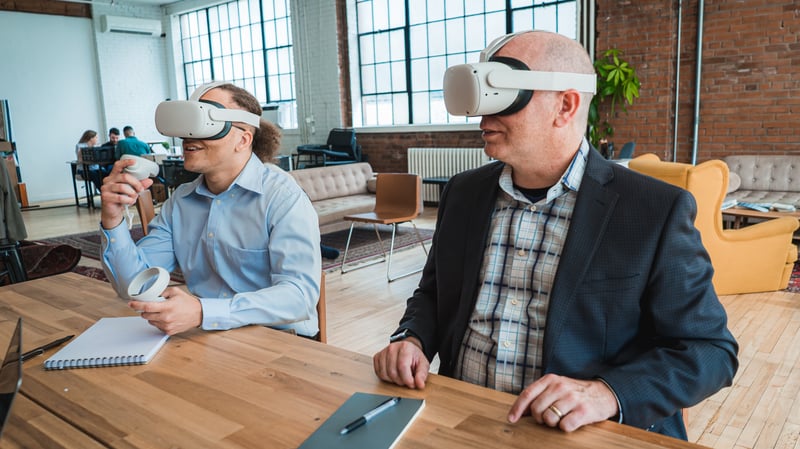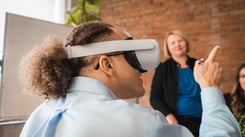Understanding the Power of VR in Architecture
Virtual reality (VR) technology has the potential to revolutionize the architecture industry by providing immersive experiences for both architects and clients. With VR, architects can create virtual 360 models of their designs, allowing them to visualize spaces and explore different design options within their team and with clients before construction even begins. This can lead to more accurate and efficient design processes, ultimately saving time and resources.
Moreover, VR can enhance communication and collaboration within architecture firms. By using VR, architects can easily share their designs with colleagues and clients, facilitating better understanding and feedback. VR also enables clients to experience virtual walkthroughs of proposed designs, giving them a realistic sense of the space and helping them make informed decisions. With VR comes clarity in communication no matter the background of the audience, as your clients likely don’t have the design or construction know-how.
However, many people, including leaders and decision-makers at architecture firms still are hesitant to embrace the power of VR. This could be from a reluctance to new tech, or concerns about what it costs to invest into VR. So how does one convince others to use impactful VR technology? Overall, understanding the impact of VR in architecture is crucial for effectively championing this technology at your firm. If you approach decision-makers at your firm with the tips and tricks in this article, you will have the best chance of showing them the power of VR in architecture.
Crafting a Compelling Pitch for Decision Makers
When pitching VR to decision-makers at your architecture firm, it's important to highlight the numerous benefits and potential return on investment (ROI) that VR can offer. Consider the following points when crafting your pitch:
- Emphasize the cost-saving potential of VR by explaining how it can minimize errors and changes during the design phase, resulting in fewer costly revisions during construction. Leaders are always looking for ways to minimize costs during these phases.
- Discuss the enhanced collaboration and communication capabilities of VR, emphasizing how it can streamline the feedback process and improve project outcomes. Tools like Yulio even have collaboration tools built in for remote and in-person meetings.
- Showcase case studies or success stories from other architecture firms that have successfully implemented VR technology, demonstrating its positive impact on design quality and client satisfaction. Feel free even to use some of our VR success stories!
- Highlight the competitive advantage that VR can provide, as firms that embrace innovative technologies like VR are more likely to attract clients and stand out in the industry. There are always many competitors to stand out from and a VR presentation is much more memorable than a traditional replacement.
By presenting a compelling pitch that focuses on the benefits and potential ROI of VR, you can increase the chances of decision-makers embracing this technology at your architecture firm.

Addressing Common Concerns and Objections
When introducing VR technology to decision-makers, it's important to anticipate and address any common concerns or objections they may have. Some common concerns about VR in architecture include:
- Cost: Decision makers may be worried about the initial investment required to implement VR technology. Address this concern by highlighting the long-term cost savings that VR can provide through improved design accuracy and reduced revisions during construction. Also, let them know there are different levels of investing in VR. You don’t necessarily need to kit your entire team out with VR headsets, you can experiment with tools like Yulio and see how they fit into your workflows.
- Learning Curve: Decision makers may be concerned about the learning curve associated with adopting VR technology. Assure them that the learning curve is manageable, and provide information about training resources and support available to employees. At Yulio we offer regular training webinars, an expansive knowledge base, and even a learning portal for new users. It’s not like learning a new CAD software.
- Compatibility: Decision makers may worry about how VR technology integrates with existing software and workflows. Explain that VR tools can seamlessly integrate with popular design software, ensuring compatibility and minimizing disruption to existing processes. Yulio has plugins for Revit and other design programs, but we have wide compatibility with other programs such as Enscape and Twinmotion.
By proactively addressing these concerns and objections, decision-makers will feel more confident and comfortable embracing VR technology at your architecture firm.
Training Your Team for VR Implementation
To successfully implement VR technology at your architecture firm, providing adequate training to your team is essential. Your decision makers will want to know how you plan to onboard new VR users so it would be prudent to come to them with a detailed training plan. Consider the following steps for training your team:
- Start with basic VR training sessions to familiarize your team with the hardware and software used in VR technology. Get them hands-on with basic examples of VR tech
- Provide hands-on practice opportunities for your team to create and navigate virtual 3D models, allowing them to gain confidence and proficiency in using VR tools. Using a tool like Yulio, build a VR project from the bottom up to showcase the ease of the software and the features it adds such as hotspots and floorplans views.
- Offer advanced training sessions to explore more advanced features and capabilities of VR technology, enabling your team to leverage its potential fully. Maybe now is when you consider moving to a VR headset of some kind to highlight the immersive nature of using VR with a headset and the impact it could have on clients.
- Encourage continuous learning and provide resources for your team to stay updated with the latest developments in VR technology and its applications in architecture.
By investing in training for your team, you can ensure a smooth and successful implementation of VR technology at your architecture firm.

Start Bringing The Power of VR in Architecture to Your Firm
We now hope you have a good idea of how you can approach decision-makers and leaders at your firm to showcase the power of VR. Make sure you craft a detailed pitch with data and success stories of VR. Be ready to address common concerns that new users can have to using VR and offer solutions that are easy to implement. And finally, make sure you have a plan on how to train the team in VR and how to properly work it into their processes.







